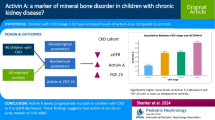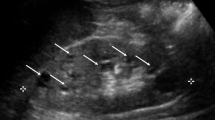Abstract
Summary
Osteopetrosis is a group of genetic bone disorders. Mutations in the chloride channel 7 gene (CLCN7) lead to chloride channel defect, which results in autosomal dominant osteopetrosis type II (ADO-II), autosomal recessive osteopetrosis (ARO), and intermediate autosomal recessive osteopetrosis (IARO). In the present study, we identified seven novel mutations of the CLCN7 gene and reported the first case of IARO with compound heterozygous mutation in Chinese population.
Introduction
Osteopetrosis is a heritable bone disorder due to the deficiency of or function defect in osteoclasts. Mutations in the CLCN7 lead to chloride channel defects, which result in osteopetrosis with diverse severity ranging from asymptomatic or relatively mild symptoms in ADO-II to the very severe phenotype in ARO. Heterozygous mutations in CLCN7 are associated to ADO-II, while homozygous and compound heterozygous mutations in CLCN7 may result in ARO and IARO. To date, a total of 24 mutations in CLCN7 were identified in ADO-II, and only 3 mutations were identified in IARO. In the present study, we reported seven unrelated ADO-II patients and one IARO patient from Chinese population and elucidated the characteristics of CLCN7 gene mutations in these patients.
Methods
All 25 CLCN7 exons and exon-intron boundaries from genomic DNA were amplified and sequenced in eight affected individuals suffering from ADO-II/IARO. The clinical, biochemical, and radiographic analysis were evaluated to compare the differences between ADO-II and IARO both in genotype and phenotype.
Results
The results showed that there were seven novel CLCN7 mutations identified in these ADO-II/IARO patients, including six heterozygous missense mutations (p.L224R, p.S290Y, p.R326G, p.G347R, p.S473N, and p.L564P) and a novel splice mutation (p.K691FS).
Conclusions
The compound heterozygous mutations (p.L224R and p.K691FS) were firstly observed in one IARO patient. The present study would enrich the database of CLCN7 mutations and improve our understanding of this heritable bone disorder.




Similar content being viewed by others
References
Frattini A, Pangrazio A, Susani L, Sobacchi C, Mirolo M, Abinun M, Andolina M, Flanagan A, Horwitz EM, Mihci E, Notarangelo LD, Ramenghi U, Teti A, Van Hove J, Vujic D, Young T, Albertini A, Orchard PJ, Vezzoni P, Villa A (2003) Chloride channel ClCN7 mutations are responsible for severe recessive, dominant, and intermediate osteopetrosis. J Bone Miner Res 18:1740–1747
Okamoto F, Kajiya H, Fukushima H, Jimi E, Okabe K (2004) Prostaglandin E2 activates outwardly rectifying Cl(-) channels via a cAMP-dependent pathway and reduces cell motility in rat osteoclasts. Am J Physiol Cell Physiol 287:C114–C124
Kelly ME, Dixon SJ, Sims SM (1994) Outwardly rectifying chloride current in rabbit osteoclasts is activated by hyposmotic stimulation. J Physiol 475:377–389
Pangrazio A, Pusch M, Caldana E, Frattini A, Lanino E, Tamhankar PM, Phadke S, Lopez AG, Orchard P, Mihci E, Abinun M, Wright M, Vettenranta K, Bariae I, Melis D, Tezcan I, Baumann C, Locatelli F, Zecca M, Horwitz E, Mansour LS, Van Roij M, Vezzoni P, Villa A, Sobacchi C (2010) Molecular and clinical heterogeneity in CLCN7-dependent osteopetrosis: report of 20 novel mutations. Hum Mutat 31:E1071–E1080
Waguespack SG, Koller DL, White KE, Fishburn T, Carn G, Buckwalter KA, Johnson M, Kocisko M, Evans WE, Foroud T, Econs MJ (2003) Chloride channel 7 (ClCN7) gene mutations and autosomal dominant osteopetrosis, type II. J Bone Miner Res 18:1513–1518
Faundez V, Hartzell HC (2004) Intracellular chloride channels: determinants of function in the endosomal pathway. Sci STKE e8
Stark Z, Savarirayan R (2009) Osteopetrosis. Orphanet J Rare Dis 4:5
Whyte MP, Kempa LG, McAlister WH, Zhang F, Mumm S, Wenkert D (2010) Elevated serum lactate dehydrogenase isoenzymes and aspartate transaminase distinguish Albers-Schonberg disease (chloride channel 7 deficiency osteopetrosis) among the sclerosing bone disorders. J Bone Miner Res 25:2515–2526
Alatalo SL, Ivaska KK, Waguespack SG, Econs MJ, Vaananen HK, Halleen JM (2004) Osteoclast-derived serum tartrate-resistant acid phosphatase 5b in Albers-Schonberg disease (type II autosomal dominant osteopetrosis). Clin Chem 50:883–890
Henriksen K, Gram J, Schaller S, Dahl BH, Dziegiel MH, Bollerslev J, Karsdal MA (2004) Characterization of osteoclasts from patients harboring a G215R mutation in ClC-7 causing autosomal dominant osteopetrosis type II. Am J Pathol 164:1537–1545
Campos-Xavier AB, Casanova JL, Doumaz Y, Feingold J, Munnich A, Cormier-Daire V (2005) Intrafamilial phenotypic variability of osteopetrosis due to chloride channel 7 (CLCN7) mutations. Am J Med Genet A 133A:216–218
Cleiren E, Benichou O, Van Hul E, Gram J, Bollerslev J, Singer FR, Beaverson K, Aledo A, Whyte MP, Yoneyama T, DeVernejoul MC, Van Hul W (2001) Albers-Schonberg disease (autosomal dominant osteopetrosis, type II) results from mutations in the ClCN7 chloride channel gene. Hum Mol Genet 10:2861–2867
Letizia C, Taranta A, Migliaccio S, Caliumi C, Diacinti D, Delfini E, D’Erasmo E, Iacobini M, Roggini M, Albagha OM, Ralston SH, Teti A (2004) Type II benign osteopetrosis (Albers-Schonberg disease) caused by a novel mutation in CLCN7 presenting with unusual clinical manifestations. Calcif Tissue Int 74:42–46
Zhang ZL, He JW, Zhang H, Hu WW, Fu WZ, Gu JM, Yu JB, Gao G, Hu YQ, Li M, Liu YJ (2009) Identification of the CLCN7 gene mutations in two Chinese families with autosomal dominant osteopetrosis (type II). J Bone Miner Metab 27:444–451
Wang C, Zhang H, He JW, Gu JM, Hu WW, Hu YQ, Li M, Liu YJ, Fu WZ, Yue H, Ke YH, Zhang ZL (2012) The virulence gene and clinical phenotypes of osteopetrosis in the Chinese population: six novel mutations of the CLCN7 gene in twelve osteopetrosis families. J Bone Miner Metab 30:338–348
Zheng H, Zhang Z, He JW, Fu WZ, Wang C, Zhang ZL (2014) Identification of two novel CLCN7 gene mutations in three Chinese families with autosomal dominant osteopetrosis type II. Joint Bone Spine 81:188–189
Rashid BM, Rashid NG, Schulz A, Lahr G, Nore BF (2013) A novel missense mutation in the CLCN7 gene linked to benign autosomal dominant osteopetrosis: a case series. J Med Case Rep 7:7
Xue Y, Wang W, Mao T, Duan X (2012) Report of two Chinese patients suffering from CLCN7-related osteopetrosis and root dysplasia. J Craniomaxillofac Surg 40:416–420
Schmidt-Rose T, Jentsch TJ (1997) Transmembrane topology of a CLC chloride channel. Proc Natl Acad Sci U S A 94:7633–7638
Campos-Xavier AB, Saraiva JM, Ribeiro LM, Munnich A, Cormier-Daire V (2003) Chloride channel 7 (CLCN7) gene mutations in intermediate autosomal recessive osteopetrosis. Hum Genet 112:186–189
Waguespack SG, Hui SL, Dimeglio LA, Econs MJ (2007) Autosomal dominant osteopetrosis: clinical severity and natural history of 94 subjects with a chloride channel 7 gene mutation. J Clin Endocrinol Metab 92:771–778
Mitri Z, Tangpricha V (2012) Osteopetrosis, hypophosphatemia, and phosphaturia in a young man: a case presentation and differential diagnosis. Case Rep Endocrinol 238364
Chu K, Koller DL, Snyder R, Fishburn T, Lai D, Waguespack SG, Foroud T, Econs MJ (2005) Analysis of variation in expression of autosomal dominant osteopetrosis type 2: searching for modifier genes. Bone 37:655–661
Acknowledgments
We appreciate the patients and their family members for their participating in this study.
This study was supported by the National Science and Technology Major Projects for “Major New Drugs Innovation and Development” (No.2008ZX09312-016), the National Natural Science Foundation of China (No. 81070687, 81170805), the National Key Program of Clinical Science (No. WBYZ2011-873), the Beijing Natural Science Foundation (No. 7121012), and the Scientific Research Foundation of Beijing Medical Development (No. 2007-3029).
Conflicts of interest
Qianqian Pang, Yue Chi, Zhen Zhao, Xiaoping Xing, Mei Li, Ou Wang, Yan Jiang, Ruoxi Liao, Yue Sun, Jin Dong, and Weibo Xia declare that they have no conflict of interest.
Author information
Authors and Affiliations
Corresponding author
Electronic supplementary material
Below is the link to the electronic supplementary material.
Figure S1
Protein sequence alignment of the flanking regions of the mutations among different species. These missense mutations all occur at highly conserved positions, as shown by a comparison of the protein sequence from seven or eight vertebrates (From BLAST®, NCBI database). The mutations found in this study and the positions of amino acid were marked by blue rectangle. (GIF 81 kb)
Table S1
(DOCX 20 kb)
Table S2
(DOCX 25 kb)
Rights and permissions
About this article
Cite this article
Pang, Q., Chi, Y., Zhao, Z. et al. Novel mutations of CLCN7 cause autosomal dominant osteopetrosis type II (ADO-II) and intermediate autosomal recessive osteopetrosis (IARO) in Chinese patients. Osteoporos Int 27, 1047–1055 (2016). https://doi.org/10.1007/s00198-015-3320-x
Received:
Accepted:
Published:
Issue Date:
DOI: https://doi.org/10.1007/s00198-015-3320-x




